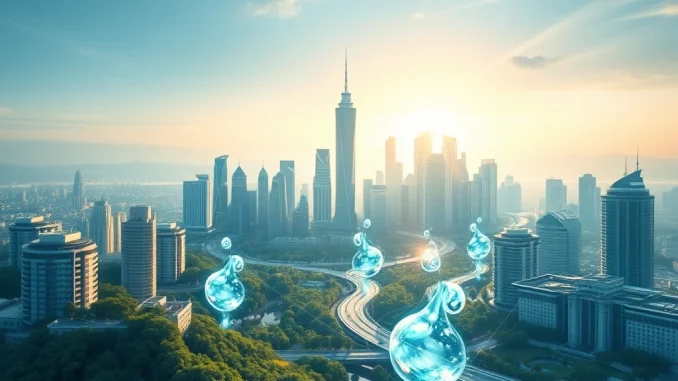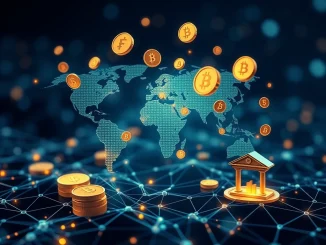
In an exciting development at the intersection of environmental sustainability and blockchain technology, Portugal’s leading water management company, Indaqua, is pioneering a groundbreaking initiative. Partnering with Hypercube’s Wateract (WRT), Indaqua is set to tokenize water credits using the Algorand blockchain. This innovative approach, recently highlighted by the Algorand Foundation, aims to transform wastewater into valuable WRT credits, offering companies a powerful tool to offset their environmental impact. Are you ready to dive into how this initiative is leveraging the power of blockchain for a greener future?
Unlocking Sustainability with Algorand and Water Credits
The pressing need for corporate sustainability is no longer a whisper; it’s a resounding call. Companies worldwide are under increasing pressure to minimize their environmental footprint, and water usage is a critical aspect of this. Enter water credits – a mechanism designed to quantify and trade water conservation efforts. But what exactly are water credits, and why are they becoming increasingly vital?
- Quantifying Water Conservation: Water credits represent a verified reduction in water usage or an improvement in water quality. Think of them as environmental offsets, similar to carbon credits but specifically focused on water.
- Incentivizing Responsible Water Management: By creating a tradable asset from water conservation, businesses are incentivized to adopt more efficient water management practices. This can range from upgrading industrial processes to investing in water-saving technologies.
- Addressing Water Scarcity: In regions facing water scarcity, water credits can play a crucial role in balancing water demand and supply. They encourage conservation where it’s needed most and allow for a market-driven approach to resource management.
- Transparency and Accountability: A robust water credit system, especially when underpinned by blockchain, offers transparency and accountability in tracking and verifying water conservation efforts.
Indaqua’s initiative with Hypercube’s WRT is perfectly positioned to capitalize on these benefits, bringing a much-needed layer of innovation to traditional water management practices.
The Power of Tokenization: Transforming Wastewater into Opportunity
At the heart of this innovative project lies the concept of tokenization. But what does it mean to tokenize water credits, and why is it a game-changer? Essentially, tokenization is the process of converting rights or units of value into a digital token on a blockchain. In this case, wastewater treatment is being converted into WRT credits, represented as digital tokens on the Algorand blockchain. Let’s break down the key aspects:
- Digital Representation of Value: WRT tokens act as a digital representation of the environmental value created by treating wastewater. Each token corresponds to a specific amount of treated water, verified and recorded on the blockchain.
- Enhanced Transparency and Traceability: Leveraging blockchain technology, every WRT credit is traceable and transparent. Transactions and ownership are immutably recorded, providing a high level of trust and security.
- Streamlined Trading and Offsetting: Tokenization facilitates the easy trading and exchange of water credits. Companies looking to offset their water footprint can readily purchase WRT tokens, knowing they are investing in verified water conservation efforts.
- Scalability and Efficiency: Compared to traditional methods of environmental offsetting, tokenization offers scalability and efficiency. The digital nature of tokens allows for faster transactions and reduced administrative overhead.
This move towards tokenization not only modernizes the water credit system but also opens up new avenues for businesses to engage with and contribute to environmental sustainability in a tangible and measurable way.
Algorand: The Blockchain Foundation for Sustainable Water Credits
Why was Algorand chosen as the blockchain for this pioneering project? Algorand, a carbon-negative blockchain platform, is renowned for its commitment to sustainability, speed, and security. Its features make it an ideal choice for environmentally focused initiatives like Indaqua’s water credit tokenization. Consider these key advantages:
| Feature | Benefit for Water Credit Tokenization |
|---|---|
| Carbon-Negative Footprint | Aligns perfectly with the sustainability goals of water credit initiatives, ensuring the technology itself is environmentally responsible. |
| High Transaction Speed & Low Fees | Enables efficient and cost-effective trading of WRT credits, crucial for market adoption and scalability. |
| Security and Immutability | Provides a secure and tamper-proof record of water credit transactions, fostering trust and transparency. |
| Smart Contract Capabilities | Allows for the automation of water credit issuance and verification processes, streamlining operations and reducing manual errors. |
| Scalability | Capable of handling a large volume of transactions, essential for the potential widespread adoption of water credits. |
By leveraging Algorand, Indaqua and Hypercube are ensuring that their water credit system is not only effective but also built on a foundation of environmental responsibility and technological excellence.
Hypercube’s Wateract (WRT): The Utility Token Bridging Wastewater and Corporate Responsibility
Hypercube’s Wateract (WRT) token is the engine driving this innovative ecosystem. It serves as the utility token that represents the water credits generated from Indaqua’s wastewater treatment processes. Understanding the role of WRT is key to grasping the full potential of this initiative:
- Representing Treated Wastewater: Each WRT token issued corresponds to a specific volume of wastewater that Indaqua has treated and purified. This directly links the token to tangible environmental action.
- Facilitating Water Footprint Offsetting: Companies can purchase WRT tokens to offset their water footprint. This provides a mechanism for businesses to compensate for their water usage by investing in water conservation efforts.
- Driving Investment in Water Treatment: The demand for WRT tokens can incentivize further investment in wastewater treatment infrastructure and technologies, creating a positive feedback loop for environmental improvement.
- Creating a Water Credit Market: WRT tokens contribute to the development of a functional water credit market, where the value of water conservation can be recognized and traded.
WRT is more than just a cryptocurrency; it’s a tool for driving real-world environmental impact, connecting corporate responsibility with tangible water conservation efforts.
Benefits Galore: Why This Initiative is a Win-Win
The collaboration between Indaqua and Hypercube, powered by Algorand, presents a multitude of benefits across different sectors. This isn’t just about environmental goodwill; it’s about creating a system that is economically sound, environmentally responsible, and technologically advanced. Let’s explore the key advantages:
- For Companies:
- Simplified Water Footprint Offsetting: Easily purchase WRT tokens to offset water usage and meet sustainability targets.
- Enhanced ESG Reporting: Demonstrate tangible commitment to environmental, social, and governance (ESG) goals.
- Improved Brand Image: Showcase leadership in environmental innovation and attract environmentally conscious customers and investors.
- For Indaqua:
- New Revenue Streams: Generate revenue from issuing WRT tokens based on wastewater treatment.
- Recognition as an Innovator: Position themselves at the forefront of sustainable water management and technological adoption.
- Increased Efficiency: Potentially optimize wastewater treatment processes through data insights gained from the blockchain system.
- For the Environment:
- Incentivized Water Conservation: Drive greater investment and effort in water conservation and wastewater treatment.
- Reduced Water Stress: Contribute to more sustainable water resource management, especially in water-stressed regions.
- Transparent and Accountable System: Ensure verifiable and traceable water conservation efforts.
The synergy created by this initiative promises a positive impact on businesses, the environment, and the broader adoption of sustainable practices.
Navigating the Waters: Challenges and the Path Forward
While the potential of water credits tokenized on the blockchain is immense, it’s important to acknowledge the challenges and consider the future trajectory of such initiatives. What hurdles might Indaqua and Hypercube face, and what does the future hold?
- Regulatory Landscape: Water rights and environmental regulations vary significantly across jurisdictions. Navigating these complexities and ensuring compliance will be crucial for scalability.
- Market Adoption: Creating a robust market for WRT tokens requires widespread awareness and acceptance from companies looking to offset their water footprint. Education and outreach will be key.
- Verification and Standardization: Establishing standardized methodologies for verifying water credits and ensuring the integrity of the system is paramount for maintaining trust and credibility.
- Scalability and Interoperability: Expanding the initiative to other regions and ensuring interoperability with other environmental credit systems will be important for long-term success.
Despite these challenges, the pioneering work of Indaqua and Hypercube sets a powerful precedent. As regulatory frameworks evolve and market awareness grows, we can expect to see more innovative solutions leveraging blockchain for environmental sustainability.
A Sustainable Ripple Effect: Embracing Tokenized Water Credits
Indaqua’s collaboration with Hypercube’s WRT to issue water credits on the Algorand blockchain is more than just a news story; it’s a glimpse into the future of environmental sustainability. By embracing tokenization and leveraging the power of blockchain, this initiative is paving the way for a more transparent, efficient, and impactful approach to water resource management. As companies increasingly prioritize sustainability, solutions like WRT offer a tangible and verifiable way to contribute to a greener planet. Keep an eye on this space – the ripple effects of this innovative project are just beginning to be felt, promising a wave of positive change in how we value and manage our precious water resources.



